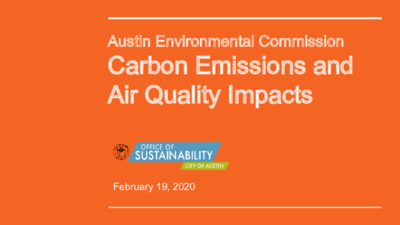20200219-004a: Carbon Emissions & Air Quality Impacts Presentation — original pdf
Backup

Austin Environmental Commission Carbon Emissions and Air Quality Impacts February 19, 2020 Carbon Impact Statement 2015 Climate Plan Net-Zero community-wide greenhouse gas (GHG) emissions by 2050. Currently being updated. 2018 Austin Community Climate Footprint Industrial 8% Natural Gas 7% Other Electricity 7% Transportation 38% Waste 2% AE Electricity 38% 12.8 million metric tons CO2e 4 Carbon Impact of New Development WHERE development happens: - near transit and alternative mobility options, - in IA Activity Centers and Corridors; HOW development is designed: - energy efficient buildings, - on-site renewable energy, - efficient land use and connectivity, - a mix of uses, and - adaptive reuse of existing buildings. Carbon Impact Checklist Tool Carbon Impact Checklist Tool TRANSPORTATION ➔ Bicycle Transit Connectivity ➔ Bicycle Infrastructure ➔ Walkability ➔ Utilize TDM Strategies ➔ Electric Vehicle Charging ➔ Maximize Parking Reductions Carbon Impact Checklist Tool LAND USE ➔ Imagine Austin Activity Center or Corridor ➔ Floor -to -Area Ratio (FAR) Carbon Impact Checklist Tool WATER + ENERGY ➔ On-site Renewable Energy ➔ Reclaimed Water Carbon Impact Checklist Tool FOOD and MATERIALS ➔ Access to Food ➔ Adaptive Reuse Projects Submitted to Date 425 W. Riverside (AKA Snoopy PUD) Project Name Holdsworth Center Goodnight Ranch Austin Green Camelback COTA 218 S. Lamar Project Total CIS Score 7 9 10 8 8 7 7 9 3501 Ed Bluestein (AKA Eightfold/Motorola) 305 Congress (AKA Statesman Site) Not yet Submitted 2018 O3 Season Weekday NOx Emissions for Austin-Round Rock-Georgetown MSA Air Quality Co-benefits • 50% of Carbon Impact Statement questions are centered on transportation • Passengers cars are the largest source of NOx emissions in the Austin-Round Rock-Georgetown MSA • Sustainable transportations choices have the biggest air quality impact on NOx/ ground -level ozone CAPCOG 2018 Air Quality Report Air Quality Updates Hack for Resilient Communities • Hosted by UT Center for Transportation Research on Saturday, February 29 th from 10:30AM -7:30PM • Call for all participants of all discipline levels to help design and implement software tools to improve community resiliency using real Austin transportation, pollution, weather and health data Localized Monitoring • PurpleAir sensors, which measure particulate matter, are used to help provide a real-time air quality monitoring network • A couple of sensors were installed by the UT Center for Transportation Research in the Dove Springs neighborhood for Hackathon event analysis • Several are installed throughout the city by different people or organizations, and the data is publicly available Special Events Ordinance Emissions Management Plan ● Encourages minimizing generator usage, properly sizing generators, and avoiding locating generators near air intake locations of nearby buildings ● Encourages specification of battery electric equipment first, but natural gas/propane equipment over diesel and gasoline ● Calls for creating clear event policy and education materials to limit vehicle idling for no longer than 5 minutes ● Events affected by this ordinance in our database include: Grand Prix, WGC Dell Technologies Match Play, Austin City Limits Potential Next Steps… Update the CIS to incorporate Air Quality. Ensure that the CIS tool can be more effective. Thank you!